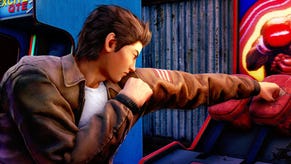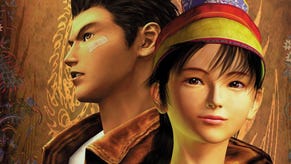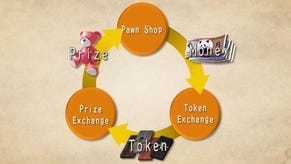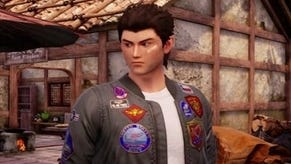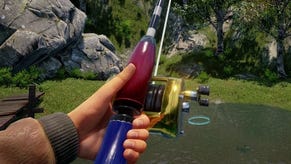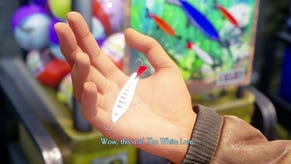Sitting down with Shenmue 3 and Yu Suzuki
I see.
This year at Gamescom, I had a remarkable opportunity to sit down and discuss Shenmue 3 with Yu Suzuki himself. As a long-time Sega fan, it was difficult not to be excited by the proposition. After all, during his tenure at Sega, Suzuki and his team at AM2 crafted many of the greatest and most influential arcade games of all time. This was followed with the incredibly ambitious Shenmue - a game I enjoyed so much that it singlehandedly sparked the creation of the DF Retro series.
I wasn't alone in my excitement. Fans the world over picked their collective jaws up off the floor in disbelief when Shenmue's unmistakable music filled the auditorium on Sony's E3 2015 stage. Shenmue 3 was to become reality and Yu Suzuki himself was building the team that would make it. It quickly became clear that this announcement was just the starting point, however, and fans would be waiting for the final product for quite some time.
On the eve of this year's Gamescom then, a new teaser was shared with the community. With facial expressions yet to be fully implemented, the trailer led some to question the progress of the game and I hoped to learn more about this during our session with Suzuki. Upon arrival at the meeting point, I was ushered into a small room neatly decorated with Shenmue themed wallpaper and, after a greeting Suzuki and executive producer Harry Morishita, my attention was quickly diverted to a TV resting at the front of the room.
An extended version of the teaser trailer played out before my eyes. This time I was given a taste of many familiar elements in Shenmue. Set against a small town bathed in the orange glow of sunset, Ryo could be seen engaging in battle, performing an extended QTE sequence and even playing a couple reflex-testing parlor games. It's not much, but between the extended look at the game world and the more familiar Shenmue trimmings, it helps.
It certainly suggests that Shenmue 3 is still some ways off but it also highlights the challenging reality of building such a game. The nature of crowdfunding means that Shenmue 3 was announced before existing in any meaningful way. Beyond that, when designing games for Sega, Suzuki was used to operating with hefty budgets and a large staff but, at a time when game budgets and staff sizes are rising to a near unsustainable levels, YsNet is tasked with creating Shenmue 3 using fewer resources than ever.
At least, that was the original plan. When discussing the development status of the game, Suzuki noted that "although we had a lot of success on Kickstarter, when we started the project we soon realized it would be very difficult to make an open world game with that budget. Since then, we have been looking for another partner to give us additional funding and to also make the game with open world elements."
Thankfully, that partner came in the form of Deep Silver whose partnership was made public at Gamescom last month. With the additional funding in place, Suzuki tells me "We originally pitched a scalable game since, as you know, Kickstarter has stretch goals and now, after finding a new partner with Deep Silver, we're able to scale up based on the original plan. I'm fully ready to make the game with a larger scale featuring open world elements." What of the original Sony partnership then? Suzuki adds "Sony is also still supporting us. Sega too, in fact! I shouldn't forget about them."
So how many people are working on the game then? Suzuki is vague but notes that "I can't tell you the exact number but it's far fewer than I had back at Sega but I can say that some people that worked with me on the original Shenmue are involved."
One aspect which separates Shenmue 3 from its forebears is its core technology. The bulk of Suzuki's work with AM2 was built using bespoke code designed specifically for each game but, with Shenmue 3, YsNet has embraced Unreal Engine 4. Suzuki tells me "Unreal Engine is a great fit for our approach because we can prototype very quickly. To me, this is a valuable feature. In my case, I take on a lot of new challenges and rely on a lot of trial and error. I need to be able to quickly see the results and try out new ideas. I feel that the concept of the Unreal Engine and my approach to developing the game is a good match."
Compared to previous projects, he tells me "because I started coding previous games from scratch, I knew pretty much everything about the program. In the case of a game engine like Unreal, however, it's a kind of 'black box' so it's more challenging to fine tune everything at a lower level. I'm working to find the best way to utilize the engine which means sometimes adjusting the game scenario or plan itself to better accommodate the tools set. Overall, though, I think it's a really good engine."
One limitation with the original Shenmue are the loading times. Due to memory constraints at the time, each area is broken up into a series of zones each divided by a loading screen. I asked Suzuki about his approach for Shenmue 3 and he told me "This time, you'll start in a large area which will require some initial loading, but compared to before the loading situation will be much better. It's much faster now." While this isn't entirely clear just yet, his statement does suggest that Shenmue 3 will adopt a more modern approach that allows players to explore interior and exterior locations seamlessly with just a single lengthier loading screen when starting up the game.
While discussing the Dreamcast originals, I was curious about the controls. After all, the Dreamcast pad itself was lacking dual analog stick requiring a different solution altogether which includes controlling forward motion with the right trigger, changing direction with the d-pad and manipulating the camera with the single analog stick. How about Shenmue 3? Suzuki explains "I haven't made up my mind yet. On one hand, I wanted to keep a similar configuration to the original game, but on the other hand, there are new trends in control that I'm considering. For the moment, I'm using the right trigger for running and the analog stick for camera control like the original. That's current setup but I haven't made up my mind yet."
From my perspective, the switch to Unreal Engine is fascinating. It's a common engine these days but, when AM2 was firing on all cylinders back in the 90s, Yu Suzuki was often working on projects being designed alongside brand-new world class arcade hardware. Games like Daytona USA, Virtua Fighter 3 and Outrun were all created without the vast libraries of documentation or experience we have today. These remarkable teams were building cutting edge arcade games from nothing - an extraordinary feat that is difficult to imagine today.
As Suzuki noted earlier, however, Unreal Engine is more flexible when it comes to prototyping ideas. It's much easier to gain an understanding of how a certain mechanic or concept will function within the game and it will be interesting to see how this freedom influences the final product. With two years of work complete, a full staff and the financial backing of Deep Silver it feels like the team is shifting into high gear.
At this point, Suzuki's assistant leans over to let me know that I have one more question. With the interview coming to an end I had to ask the one thing I've been wondering about for decades - whatever became of the rumored port of Virtua Fighter 3 for Sega Saturn? Do you remember anything?
Suzuki leans back in his chair, closes his eyes for a second before responding with a very simple "No I don't". He sat back up and continued "I honestly don't remember. I'm the type of guy that jumps into new projects one-hundred percent and that was a long time ago so I really don't remember anything about it." And thus that particular mystery continues.
With that, we stand up and I thank everyone for the brief chat before exiting the room. It's difficult to glean much from such a short session but it's clear that the passion is there. When discussing the business side of things, Suzuki presented a calm, cool image but once we started chatting about the game itself he perked up - you could feel the energy in the room. In that sense, his excitement serves to feed my excitement. Yes, some of the early looks at the game may not match expectations but, under a normal publishing arrangement, we likely wouldn't have seen the game at this point. No matter how things turn out, I can say for certain that it's great seeing Yu Suzuki creating games again, and it's clear that he's glad to be back.





